Comprehensive Evaluation Report: Asthma Management Program Analysis
VerifiedAdded on 2022/10/11
|21
|4300
|14
Report
AI Summary
This report presents an evaluation of an asthma management program from a public health perspective, focusing on resource provision, healthcare access, awareness, governance, and education. The evaluation, conducted in Australia, assesses the effectiveness of current asthma management strategies in reducing severe asthma occurrences and promoting awareness. It involves stakeholders like patients, families, healthcare workers, and government representatives. The evaluation includes a program description, evaluation design with specific questions, data collection methods (primary and secondary), and anticipated outcomes. The program's context, resources, activities, and outputs are outlined, along with a logic model. The evaluation aims to provide recommendations for improving asthma management, enhancing patient well-being, and informing policy decisions. Data collection methods include interviews, questionnaires, and document reviews to gather information on the program's impact, stakeholder perspectives, and the effectiveness of various interventions.
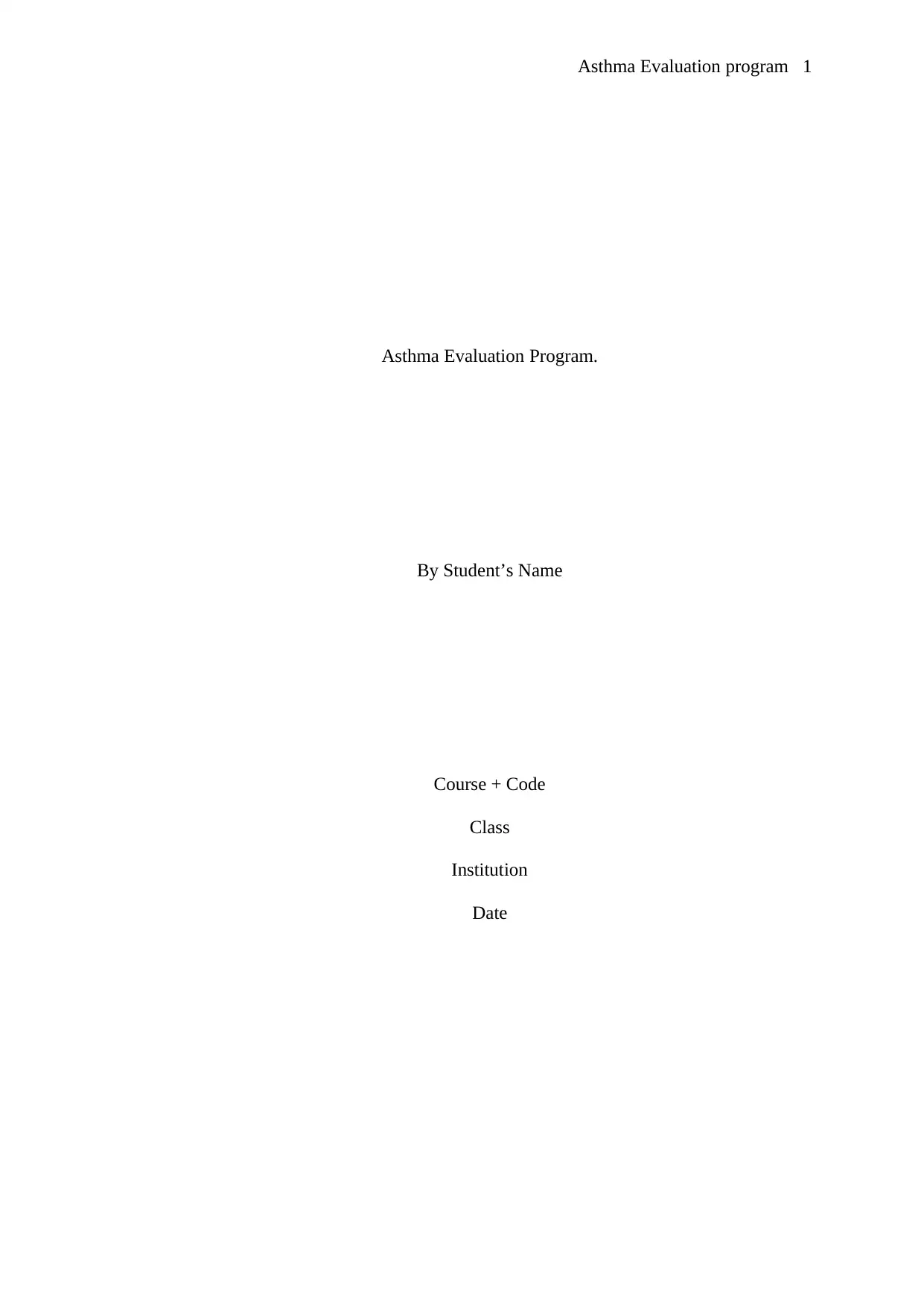
Asthma Evaluation program 1
Asthma Evaluation Program.
By Student’s Name
Course + Code
Class
Institution
Date
Asthma Evaluation Program.
By Student’s Name
Course + Code
Class
Institution
Date
Paraphrase This Document
Need a fresh take? Get an instant paraphrase of this document with our AI Paraphraser
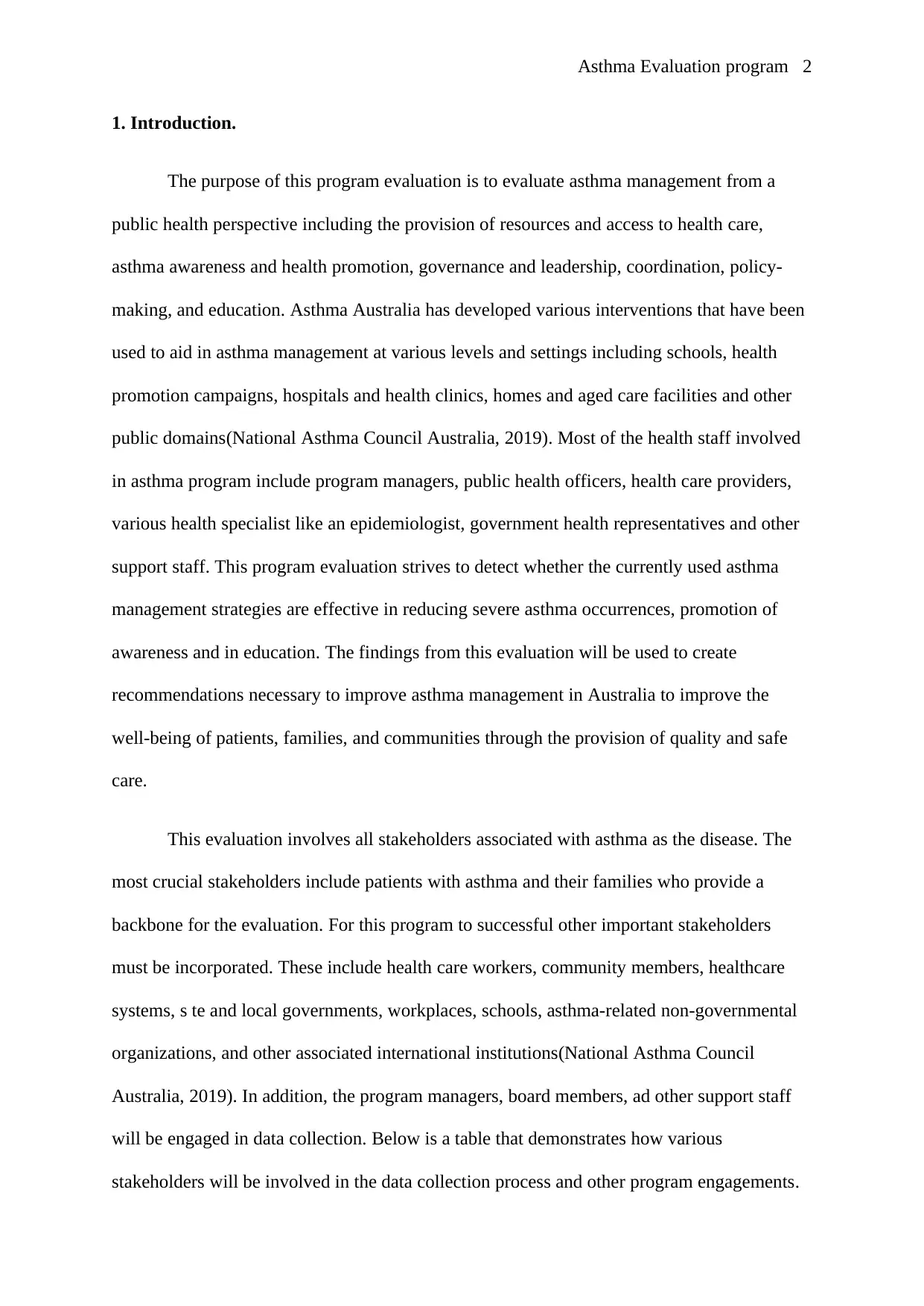
Asthma Evaluation program 2
1. Introduction.
The purpose of this program evaluation is to evaluate asthma management from a
public health perspective including the provision of resources and access to health care,
asthma awareness and health promotion, governance and leadership, coordination, policy-
making, and education. Asthma Australia has developed various interventions that have been
used to aid in asthma management at various levels and settings including schools, health
promotion campaigns, hospitals and health clinics, homes and aged care facilities and other
public domains(National Asthma Council Australia, 2019). Most of the health staff involved
in asthma program include program managers, public health officers, health care providers,
various health specialist like an epidemiologist, government health representatives and other
support staff. This program evaluation strives to detect whether the currently used asthma
management strategies are effective in reducing severe asthma occurrences, promotion of
awareness and in education. The findings from this evaluation will be used to create
recommendations necessary to improve asthma management in Australia to improve the
well-being of patients, families, and communities through the provision of quality and safe
care.
This evaluation involves all stakeholders associated with asthma as the disease. The
most crucial stakeholders include patients with asthma and their families who provide a
backbone for the evaluation. For this program to successful other important stakeholders
must be incorporated. These include health care workers, community members, healthcare
systems, s te and local governments, workplaces, schools, asthma-related non-governmental
organizations, and other associated international institutions(National Asthma Council
Australia, 2019). In addition, the program managers, board members, ad other support staff
will be engaged in data collection. Below is a table that demonstrates how various
stakeholders will be involved in the data collection process and other program engagements.
1. Introduction.
The purpose of this program evaluation is to evaluate asthma management from a
public health perspective including the provision of resources and access to health care,
asthma awareness and health promotion, governance and leadership, coordination, policy-
making, and education. Asthma Australia has developed various interventions that have been
used to aid in asthma management at various levels and settings including schools, health
promotion campaigns, hospitals and health clinics, homes and aged care facilities and other
public domains(National Asthma Council Australia, 2019). Most of the health staff involved
in asthma program include program managers, public health officers, health care providers,
various health specialist like an epidemiologist, government health representatives and other
support staff. This program evaluation strives to detect whether the currently used asthma
management strategies are effective in reducing severe asthma occurrences, promotion of
awareness and in education. The findings from this evaluation will be used to create
recommendations necessary to improve asthma management in Australia to improve the
well-being of patients, families, and communities through the provision of quality and safe
care.
This evaluation involves all stakeholders associated with asthma as the disease. The
most crucial stakeholders include patients with asthma and their families who provide a
backbone for the evaluation. For this program to successful other important stakeholders
must be incorporated. These include health care workers, community members, healthcare
systems, s te and local governments, workplaces, schools, asthma-related non-governmental
organizations, and other associated international institutions(National Asthma Council
Australia, 2019). In addition, the program managers, board members, ad other support staff
will be engaged in data collection. Below is a table that demonstrates how various
stakeholders will be involved in the data collection process and other program engagements.
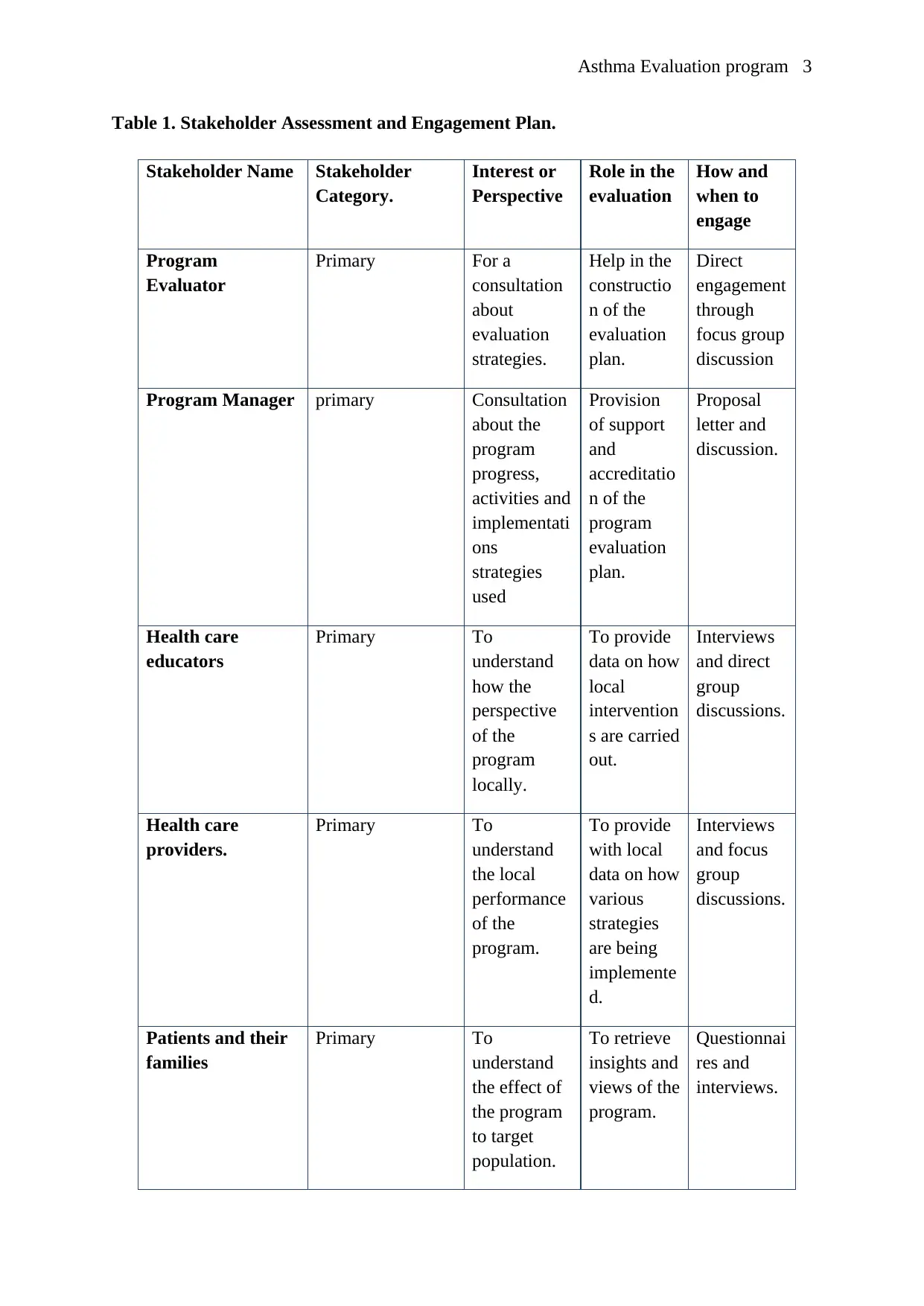
Asthma Evaluation program 3
Table 1. Stakeholder Assessment and Engagement Plan.
Stakeholder Name Stakeholder
Category.
Interest or
Perspective
Role in the
evaluation
How and
when to
engage
Program
Evaluator
Primary For a
consultation
about
evaluation
strategies.
Help in the
constructio
n of the
evaluation
plan.
Direct
engagement
through
focus group
discussion
Program Manager primary Consultation
about the
program
progress,
activities and
implementati
ons
strategies
used
Provision
of support
and
accreditatio
n of the
program
evaluation
plan.
Proposal
letter and
discussion.
Health care
educators
Primary To
understand
how the
perspective
of the
program
locally.
To provide
data on how
local
intervention
s are carried
out.
Interviews
and direct
group
discussions.
Health care
providers.
Primary To
understand
the local
performance
of the
program.
To provide
with local
data on how
various
strategies
are being
implemente
d.
Interviews
and focus
group
discussions.
Patients and their
families
Primary To
understand
the effect of
the program
to target
population.
To retrieve
insights and
views of the
program.
Questionnai
res and
interviews.
Table 1. Stakeholder Assessment and Engagement Plan.
Stakeholder Name Stakeholder
Category.
Interest or
Perspective
Role in the
evaluation
How and
when to
engage
Program
Evaluator
Primary For a
consultation
about
evaluation
strategies.
Help in the
constructio
n of the
evaluation
plan.
Direct
engagement
through
focus group
discussion
Program Manager primary Consultation
about the
program
progress,
activities and
implementati
ons
strategies
used
Provision
of support
and
accreditatio
n of the
program
evaluation
plan.
Proposal
letter and
discussion.
Health care
educators
Primary To
understand
how the
perspective
of the
program
locally.
To provide
data on how
local
intervention
s are carried
out.
Interviews
and direct
group
discussions.
Health care
providers.
Primary To
understand
the local
performance
of the
program.
To provide
with local
data on how
various
strategies
are being
implemente
d.
Interviews
and focus
group
discussions.
Patients and their
families
Primary To
understand
the effect of
the program
to target
population.
To retrieve
insights and
views of the
program.
Questionnai
res and
interviews.
⊘ This is a preview!⊘
Do you want full access?
Subscribe today to unlock all pages.

Trusted by 1+ million students worldwide
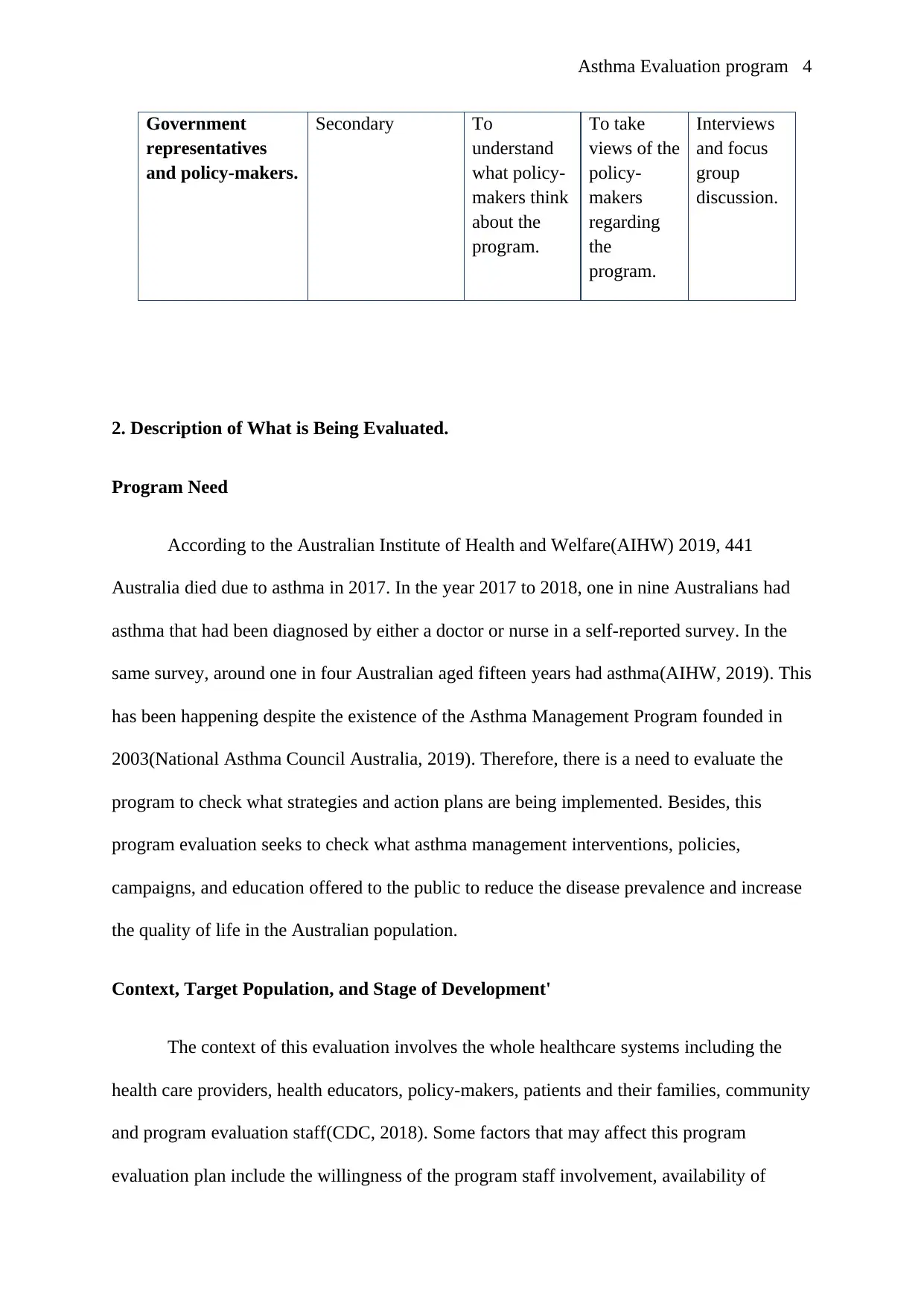
Asthma Evaluation program 4
Government
representatives
and policy-makers.
Secondary To
understand
what policy-
makers think
about the
program.
To take
views of the
policy-
makers
regarding
the
program.
Interviews
and focus
group
discussion.
2. Description of What is Being Evaluated.
Program Need
According to the Australian Institute of Health and Welfare(AIHW) 2019, 441
Australia died due to asthma in 2017. In the year 2017 to 2018, one in nine Australians had
asthma that had been diagnosed by either a doctor or nurse in a self-reported survey. In the
same survey, around one in four Australian aged fifteen years had asthma(AIHW, 2019). This
has been happening despite the existence of the Asthma Management Program founded in
2003(National Asthma Council Australia, 2019). Therefore, there is a need to evaluate the
program to check what strategies and action plans are being implemented. Besides, this
program evaluation seeks to check what asthma management interventions, policies,
campaigns, and education offered to the public to reduce the disease prevalence and increase
the quality of life in the Australian population.
Context, Target Population, and Stage of Development'
The context of this evaluation involves the whole healthcare systems including the
health care providers, health educators, policy-makers, patients and their families, community
and program evaluation staff(CDC, 2018). Some factors that may affect this program
evaluation plan include the willingness of the program staff involvement, availability of
Government
representatives
and policy-makers.
Secondary To
understand
what policy-
makers think
about the
program.
To take
views of the
policy-
makers
regarding
the
program.
Interviews
and focus
group
discussion.
2. Description of What is Being Evaluated.
Program Need
According to the Australian Institute of Health and Welfare(AIHW) 2019, 441
Australia died due to asthma in 2017. In the year 2017 to 2018, one in nine Australians had
asthma that had been diagnosed by either a doctor or nurse in a self-reported survey. In the
same survey, around one in four Australian aged fifteen years had asthma(AIHW, 2019). This
has been happening despite the existence of the Asthma Management Program founded in
2003(National Asthma Council Australia, 2019). Therefore, there is a need to evaluate the
program to check what strategies and action plans are being implemented. Besides, this
program evaluation seeks to check what asthma management interventions, policies,
campaigns, and education offered to the public to reduce the disease prevalence and increase
the quality of life in the Australian population.
Context, Target Population, and Stage of Development'
The context of this evaluation involves the whole healthcare systems including the
health care providers, health educators, policy-makers, patients and their families, community
and program evaluation staff(CDC, 2018). Some factors that may affect this program
evaluation plan include the willingness of the program staff involvement, availability of
Paraphrase This Document
Need a fresh take? Get an instant paraphrase of this document with our AI Paraphraser
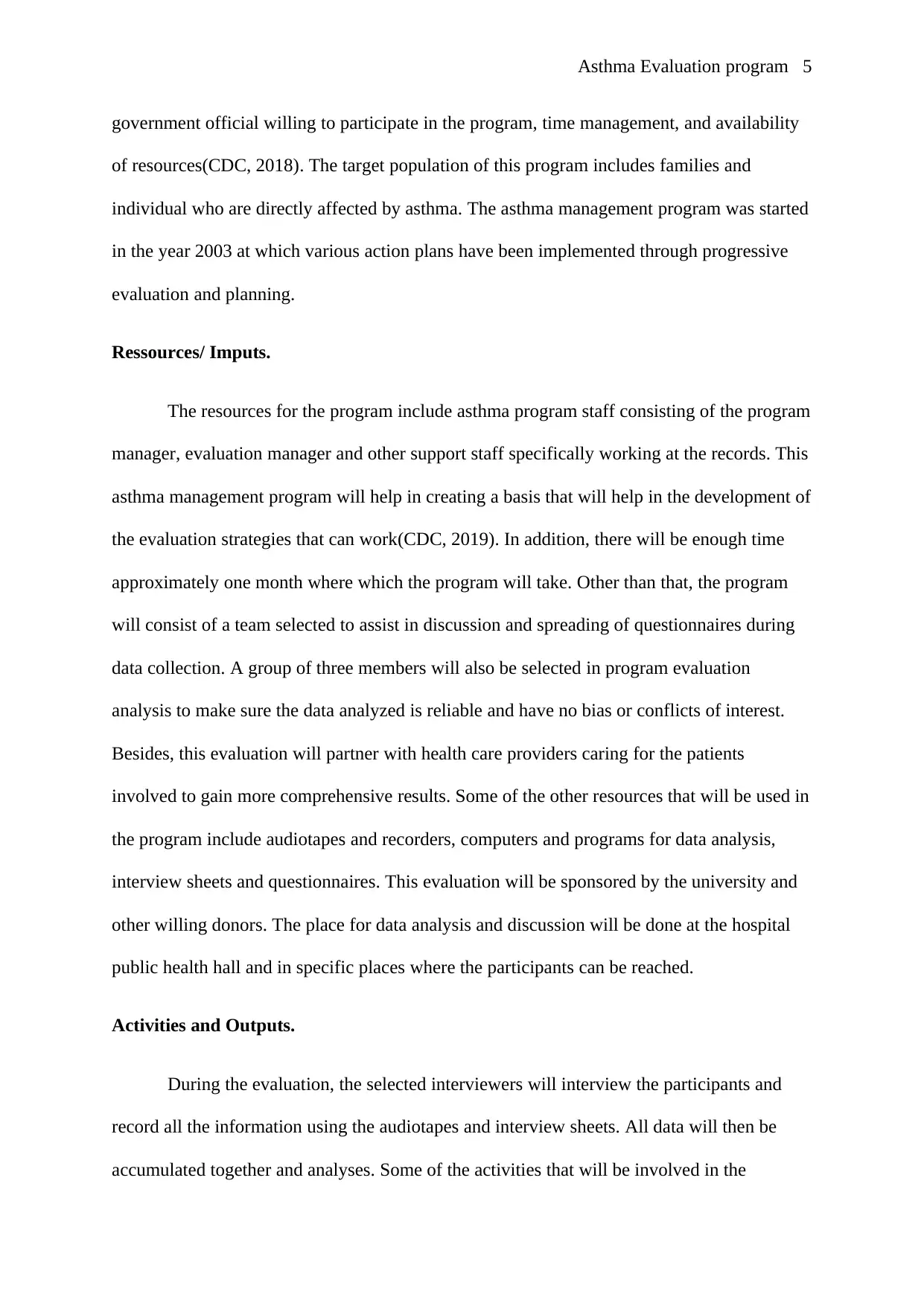
Asthma Evaluation program 5
government official willing to participate in the program, time management, and availability
of resources(CDC, 2018). The target population of this program includes families and
individual who are directly affected by asthma. The asthma management program was started
in the year 2003 at which various action plans have been implemented through progressive
evaluation and planning.
Ressources/ Imputs.
The resources for the program include asthma program staff consisting of the program
manager, evaluation manager and other support staff specifically working at the records. This
asthma management program will help in creating a basis that will help in the development of
the evaluation strategies that can work(CDC, 2019). In addition, there will be enough time
approximately one month where which the program will take. Other than that, the program
will consist of a team selected to assist in discussion and spreading of questionnaires during
data collection. A group of three members will also be selected in program evaluation
analysis to make sure the data analyzed is reliable and have no bias or conflicts of interest.
Besides, this evaluation will partner with health care providers caring for the patients
involved to gain more comprehensive results. Some of the other resources that will be used in
the program include audiotapes and recorders, computers and programs for data analysis,
interview sheets and questionnaires. This evaluation will be sponsored by the university and
other willing donors. The place for data analysis and discussion will be done at the hospital
public health hall and in specific places where the participants can be reached.
Activities and Outputs.
During the evaluation, the selected interviewers will interview the participants and
record all the information using the audiotapes and interview sheets. All data will then be
accumulated together and analyses. Some of the activities that will be involved in the
government official willing to participate in the program, time management, and availability
of resources(CDC, 2018). The target population of this program includes families and
individual who are directly affected by asthma. The asthma management program was started
in the year 2003 at which various action plans have been implemented through progressive
evaluation and planning.
Ressources/ Imputs.
The resources for the program include asthma program staff consisting of the program
manager, evaluation manager and other support staff specifically working at the records. This
asthma management program will help in creating a basis that will help in the development of
the evaluation strategies that can work(CDC, 2019). In addition, there will be enough time
approximately one month where which the program will take. Other than that, the program
will consist of a team selected to assist in discussion and spreading of questionnaires during
data collection. A group of three members will also be selected in program evaluation
analysis to make sure the data analyzed is reliable and have no bias or conflicts of interest.
Besides, this evaluation will partner with health care providers caring for the patients
involved to gain more comprehensive results. Some of the other resources that will be used in
the program include audiotapes and recorders, computers and programs for data analysis,
interview sheets and questionnaires. This evaluation will be sponsored by the university and
other willing donors. The place for data analysis and discussion will be done at the hospital
public health hall and in specific places where the participants can be reached.
Activities and Outputs.
During the evaluation, the selected interviewers will interview the participants and
record all the information using the audiotapes and interview sheets. All data will then be
accumulated together and analyses. Some of the activities that will be involved in the
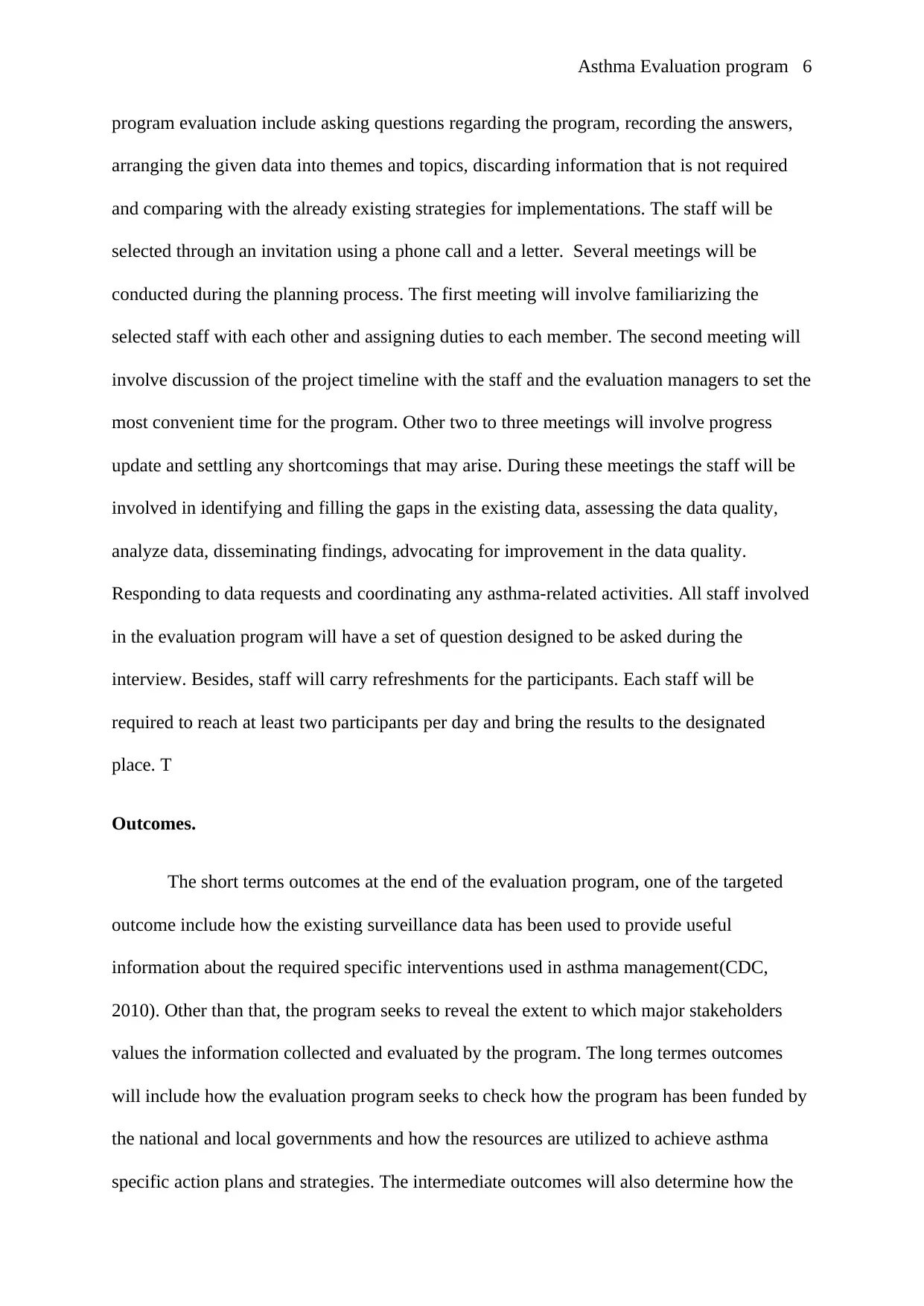
Asthma Evaluation program 6
program evaluation include asking questions regarding the program, recording the answers,
arranging the given data into themes and topics, discarding information that is not required
and comparing with the already existing strategies for implementations. The staff will be
selected through an invitation using a phone call and a letter. Several meetings will be
conducted during the planning process. The first meeting will involve familiarizing the
selected staff with each other and assigning duties to each member. The second meeting will
involve discussion of the project timeline with the staff and the evaluation managers to set the
most convenient time for the program. Other two to three meetings will involve progress
update and settling any shortcomings that may arise. During these meetings the staff will be
involved in identifying and filling the gaps in the existing data, assessing the data quality,
analyze data, disseminating findings, advocating for improvement in the data quality.
Responding to data requests and coordinating any asthma-related activities. All staff involved
in the evaluation program will have a set of question designed to be asked during the
interview. Besides, staff will carry refreshments for the participants. Each staff will be
required to reach at least two participants per day and bring the results to the designated
place. T
Outcomes.
The short terms outcomes at the end of the evaluation program, one of the targeted
outcome include how the existing surveillance data has been used to provide useful
information about the required specific interventions used in asthma management(CDC,
2010). Other than that, the program seeks to reveal the extent to which major stakeholders
values the information collected and evaluated by the program. The long termes outcomes
will include how the evaluation program seeks to check how the program has been funded by
the national and local governments and how the resources are utilized to achieve asthma
specific action plans and strategies. The intermediate outcomes will also determine how the
program evaluation include asking questions regarding the program, recording the answers,
arranging the given data into themes and topics, discarding information that is not required
and comparing with the already existing strategies for implementations. The staff will be
selected through an invitation using a phone call and a letter. Several meetings will be
conducted during the planning process. The first meeting will involve familiarizing the
selected staff with each other and assigning duties to each member. The second meeting will
involve discussion of the project timeline with the staff and the evaluation managers to set the
most convenient time for the program. Other two to three meetings will involve progress
update and settling any shortcomings that may arise. During these meetings the staff will be
involved in identifying and filling the gaps in the existing data, assessing the data quality,
analyze data, disseminating findings, advocating for improvement in the data quality.
Responding to data requests and coordinating any asthma-related activities. All staff involved
in the evaluation program will have a set of question designed to be asked during the
interview. Besides, staff will carry refreshments for the participants. Each staff will be
required to reach at least two participants per day and bring the results to the designated
place. T
Outcomes.
The short terms outcomes at the end of the evaluation program, one of the targeted
outcome include how the existing surveillance data has been used to provide useful
information about the required specific interventions used in asthma management(CDC,
2010). Other than that, the program seeks to reveal the extent to which major stakeholders
values the information collected and evaluated by the program. The long termes outcomes
will include how the evaluation program seeks to check how the program has been funded by
the national and local governments and how the resources are utilized to achieve asthma
specific action plans and strategies. The intermediate outcomes will also determine how the
⊘ This is a preview!⊘
Do you want full access?
Subscribe today to unlock all pages.

Trusted by 1+ million students worldwide
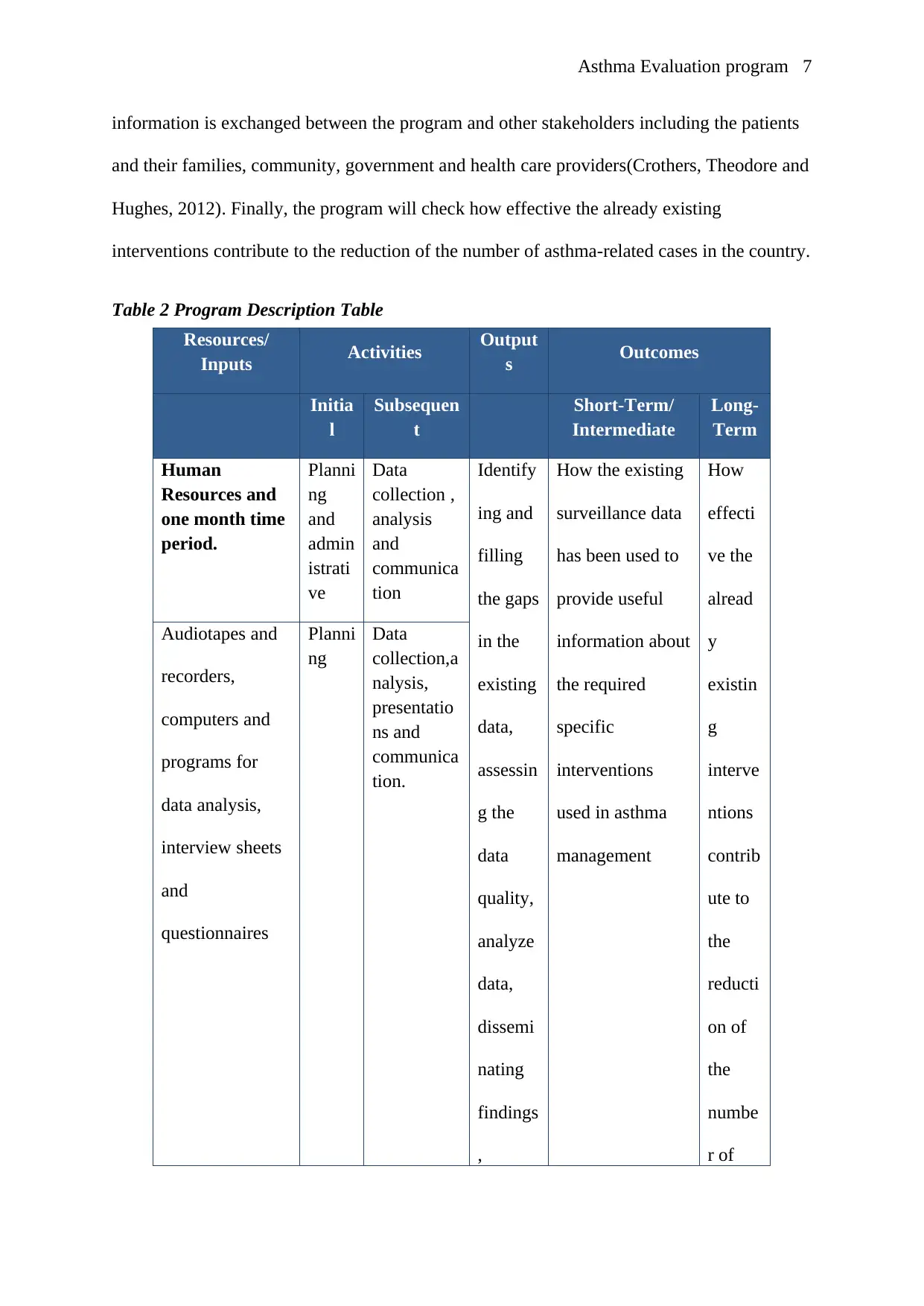
Asthma Evaluation program 7
information is exchanged between the program and other stakeholders including the patients
and their families, community, government and health care providers(Crothers, Theodore and
Hughes, 2012). Finally, the program will check how effective the already existing
interventions contribute to the reduction of the number of asthma-related cases in the country.
Table 2 Program Description Table
Resources/
Inputs Activities Output
s Outcomes
Initia
l
Subsequen
t
Short-Term/
Intermediate
Long-
Term
Human
Resources and
one month time
period.
Planni
ng
and
admin
istrati
ve
Data
collection ,
analysis
and
communica
tion
Identify
ing and
filling
the gaps
in the
existing
data,
assessin
g the
data
quality,
analyze
data,
dissemi
nating
findings
,
How the existing
surveillance data
has been used to
provide useful
information about
the required
specific
interventions
used in asthma
management
How
effecti
ve the
alread
y
existin
g
interve
ntions
contrib
ute to
the
reducti
on of
the
numbe
r of
Audiotapes and
recorders,
computers and
programs for
data analysis,
interview sheets
and
questionnaires
Planni
ng
Data
collection,a
nalysis,
presentatio
ns and
communica
tion.
information is exchanged between the program and other stakeholders including the patients
and their families, community, government and health care providers(Crothers, Theodore and
Hughes, 2012). Finally, the program will check how effective the already existing
interventions contribute to the reduction of the number of asthma-related cases in the country.
Table 2 Program Description Table
Resources/
Inputs Activities Output
s Outcomes
Initia
l
Subsequen
t
Short-Term/
Intermediate
Long-
Term
Human
Resources and
one month time
period.
Planni
ng
and
admin
istrati
ve
Data
collection ,
analysis
and
communica
tion
Identify
ing and
filling
the gaps
in the
existing
data,
assessin
g the
data
quality,
analyze
data,
dissemi
nating
findings
,
How the existing
surveillance data
has been used to
provide useful
information about
the required
specific
interventions
used in asthma
management
How
effecti
ve the
alread
y
existin
g
interve
ntions
contrib
ute to
the
reducti
on of
the
numbe
r of
Audiotapes and
recorders,
computers and
programs for
data analysis,
interview sheets
and
questionnaires
Planni
ng
Data
collection,a
nalysis,
presentatio
ns and
communica
tion.
Paraphrase This Document
Need a fresh take? Get an instant paraphrase of this document with our AI Paraphraser
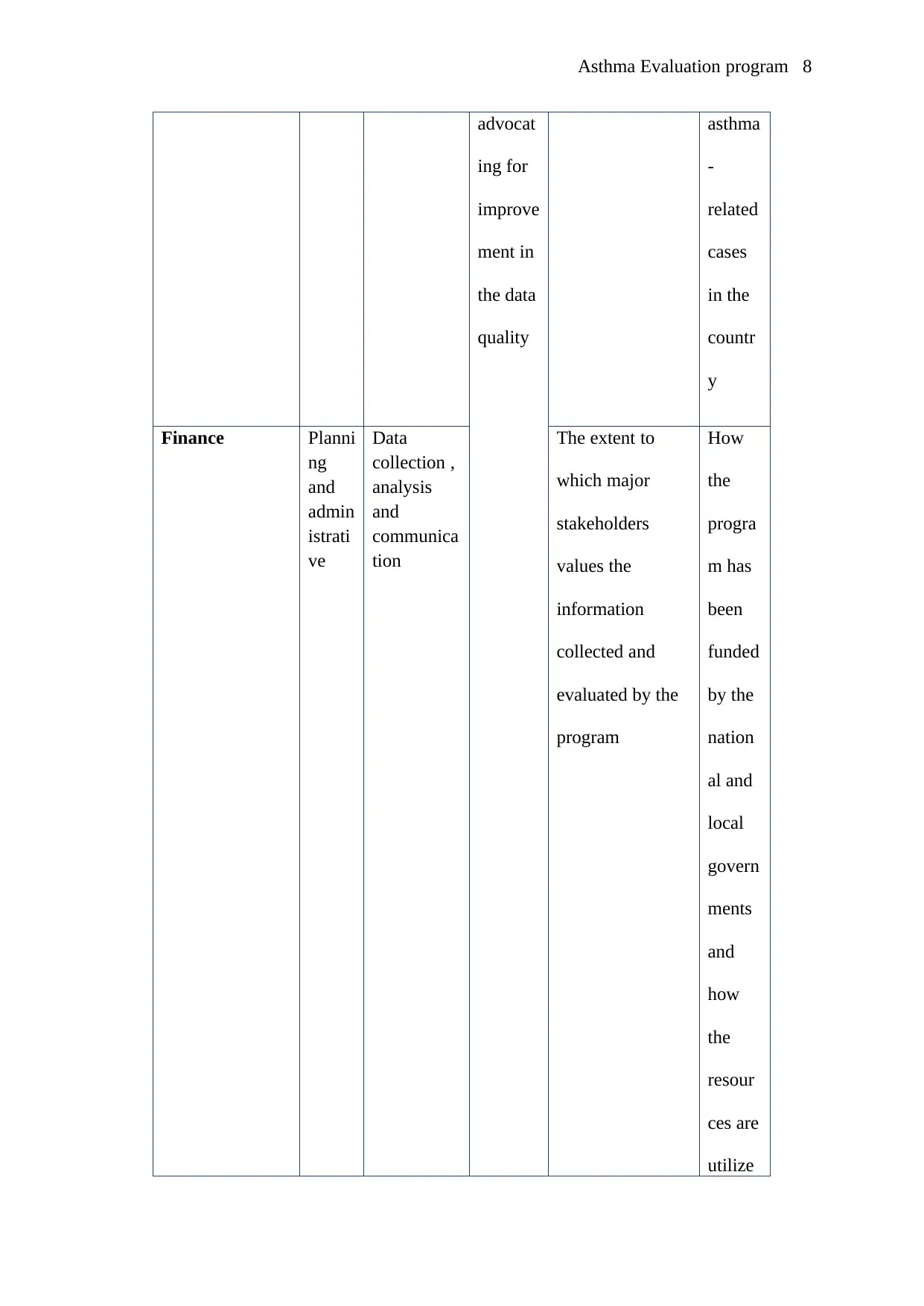
Asthma Evaluation program 8
advocat
ing for
improve
ment in
the data
quality
asthma
-
related
cases
in the
countr
y
Finance Planni
ng
and
admin
istrati
ve
Data
collection ,
analysis
and
communica
tion
The extent to
which major
stakeholders
values the
information
collected and
evaluated by the
program
How
the
progra
m has
been
funded
by the
nation
al and
local
govern
ments
and
how
the
resour
ces are
utilize
advocat
ing for
improve
ment in
the data
quality
asthma
-
related
cases
in the
countr
y
Finance Planni
ng
and
admin
istrati
ve
Data
collection ,
analysis
and
communica
tion
The extent to
which major
stakeholders
values the
information
collected and
evaluated by the
program
How
the
progra
m has
been
funded
by the
nation
al and
local
govern
ments
and
how
the
resour
ces are
utilize
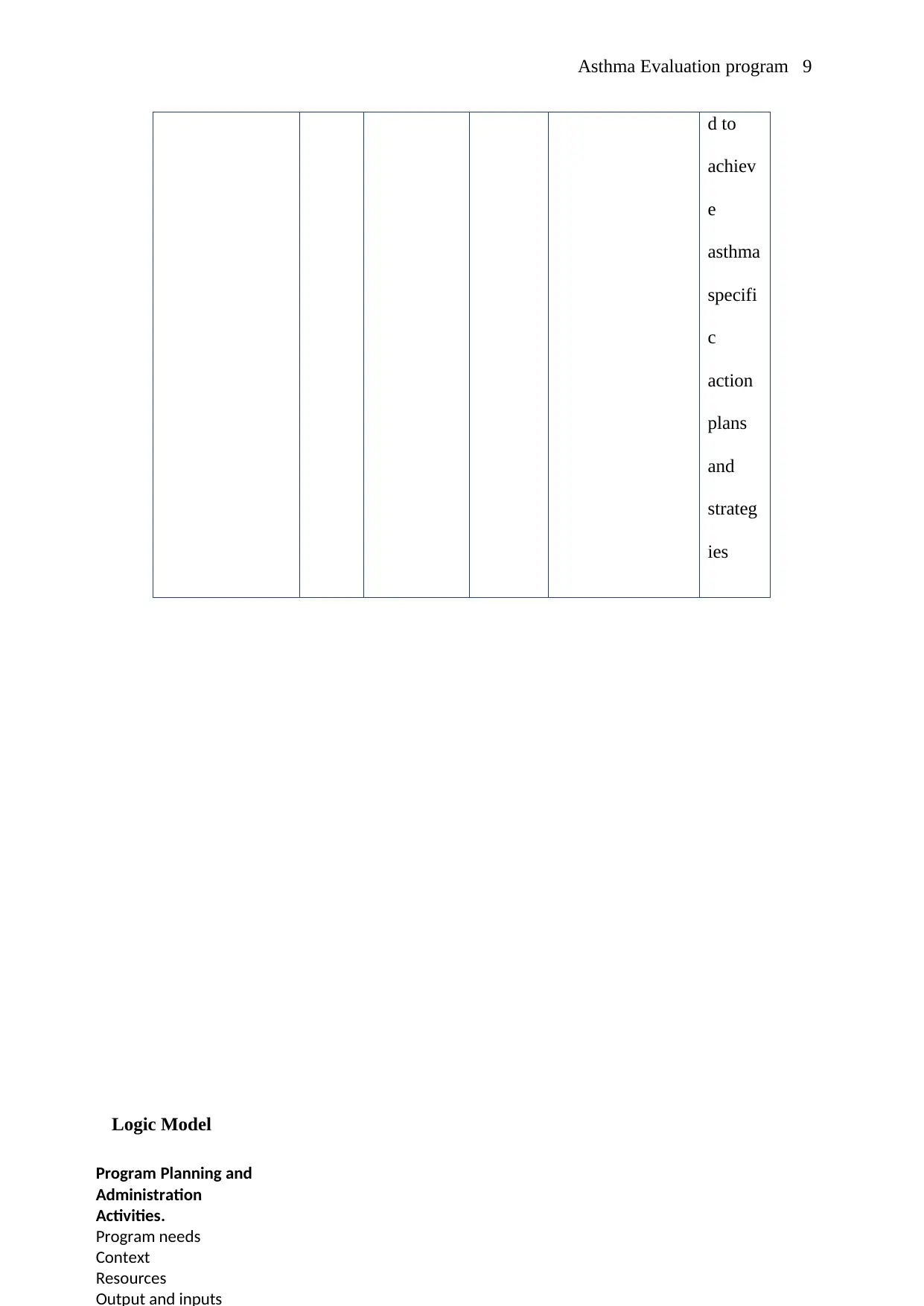
Asthma Evaluation program 9
d to
achiev
e
asthma
specifi
c
action
plans
and
strateg
ies
Logic Model
Program Planning and
Administration
Activities.
Program needs
Context
Resources
Output and inputs
d to
achiev
e
asthma
specifi
c
action
plans
and
strateg
ies
Logic Model
Program Planning and
Administration
Activities.
Program needs
Context
Resources
Output and inputs
⊘ This is a preview!⊘
Do you want full access?
Subscribe today to unlock all pages.

Trusted by 1+ million students worldwide
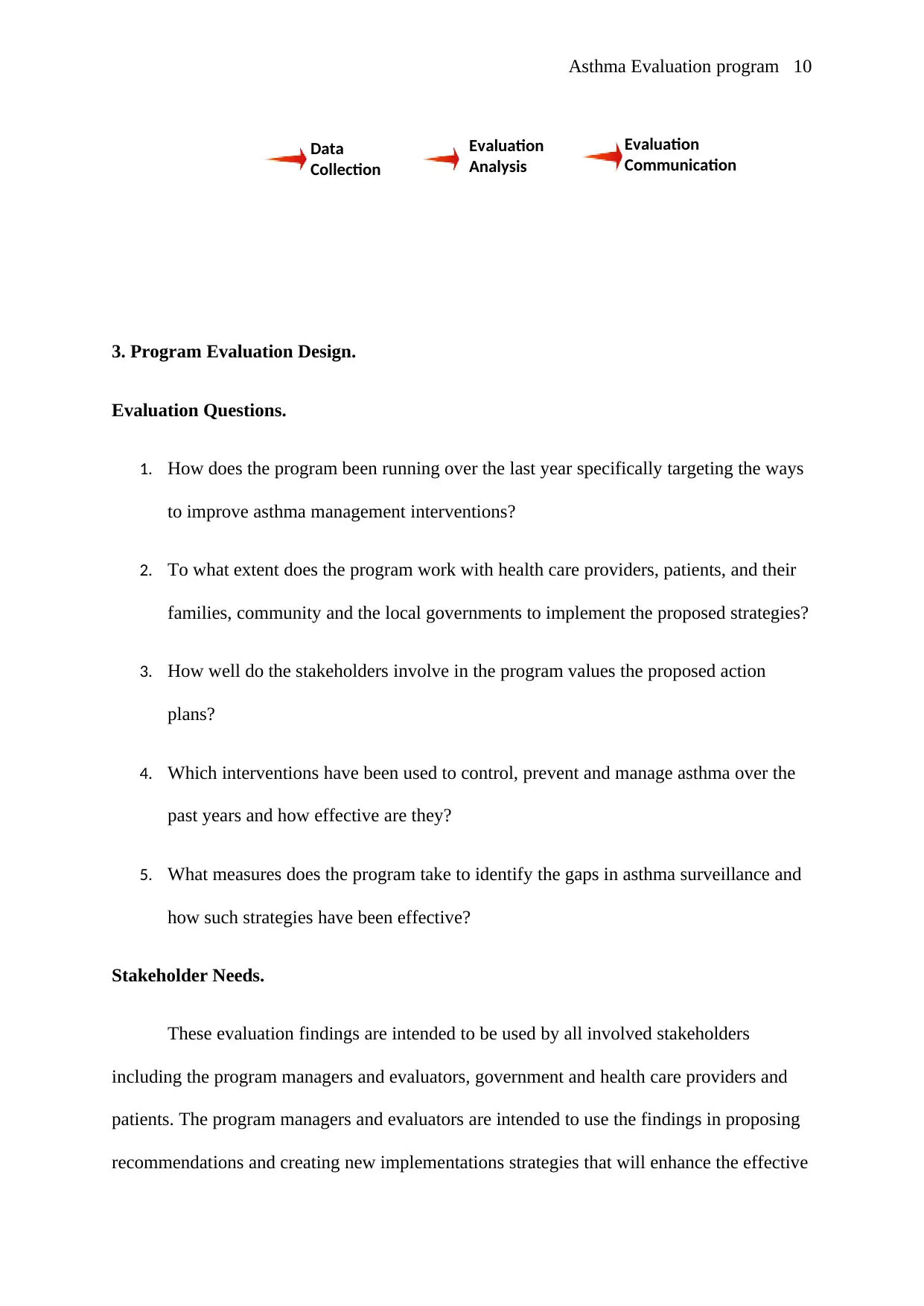
Asthma Evaluation program 10
3. Program Evaluation Design.
Evaluation Questions.
1. How does the program been running over the last year specifically targeting the ways
to improve asthma management interventions?
2. To what extent does the program work with health care providers, patients, and their
families, community and the local governments to implement the proposed strategies?
3. How well do the stakeholders involve in the program values the proposed action
plans?
4. Which interventions have been used to control, prevent and manage asthma over the
past years and how effective are they?
5. What measures does the program take to identify the gaps in asthma surveillance and
how such strategies have been effective?
Stakeholder Needs.
These evaluation findings are intended to be used by all involved stakeholders
including the program managers and evaluators, government and health care providers and
patients. The program managers and evaluators are intended to use the findings in proposing
recommendations and creating new implementations strategies that will enhance the effective
Data
Collection
Evaluation
Analysis
Evaluation
Communication
3. Program Evaluation Design.
Evaluation Questions.
1. How does the program been running over the last year specifically targeting the ways
to improve asthma management interventions?
2. To what extent does the program work with health care providers, patients, and their
families, community and the local governments to implement the proposed strategies?
3. How well do the stakeholders involve in the program values the proposed action
plans?
4. Which interventions have been used to control, prevent and manage asthma over the
past years and how effective are they?
5. What measures does the program take to identify the gaps in asthma surveillance and
how such strategies have been effective?
Stakeholder Needs.
These evaluation findings are intended to be used by all involved stakeholders
including the program managers and evaluators, government and health care providers and
patients. The program managers and evaluators are intended to use the findings in proposing
recommendations and creating new implementations strategies that will enhance the effective
Data
Collection
Evaluation
Analysis
Evaluation
Communication
Paraphrase This Document
Need a fresh take? Get an instant paraphrase of this document with our AI Paraphraser
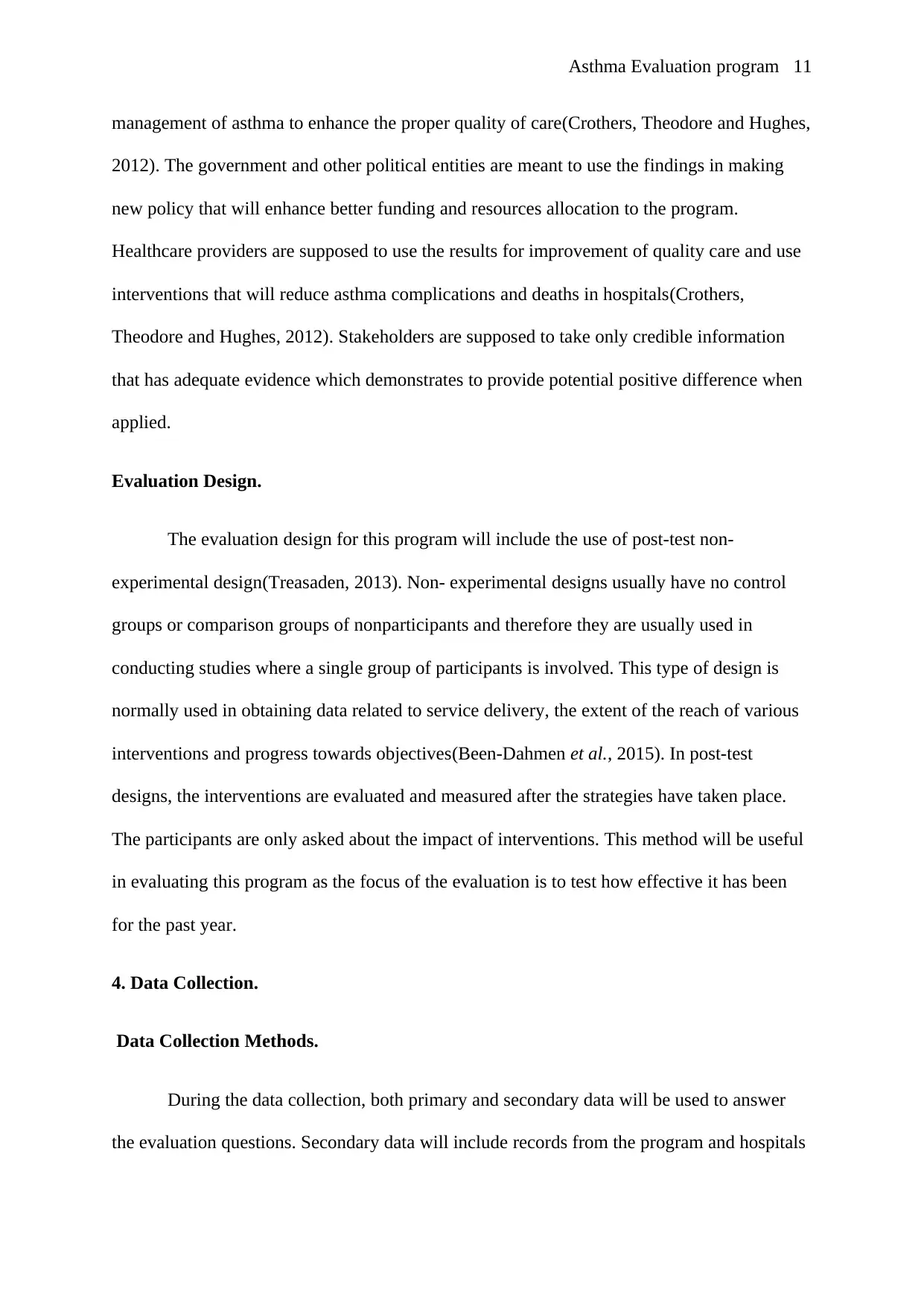
Asthma Evaluation program 11
management of asthma to enhance the proper quality of care(Crothers, Theodore and Hughes,
2012). The government and other political entities are meant to use the findings in making
new policy that will enhance better funding and resources allocation to the program.
Healthcare providers are supposed to use the results for improvement of quality care and use
interventions that will reduce asthma complications and deaths in hospitals(Crothers,
Theodore and Hughes, 2012). Stakeholders are supposed to take only credible information
that has adequate evidence which demonstrates to provide potential positive difference when
applied.
Evaluation Design.
The evaluation design for this program will include the use of post-test non-
experimental design(Treasaden, 2013). Non- experimental designs usually have no control
groups or comparison groups of nonparticipants and therefore they are usually used in
conducting studies where a single group of participants is involved. This type of design is
normally used in obtaining data related to service delivery, the extent of the reach of various
interventions and progress towards objectives(Been-Dahmen et al., 2015). In post-test
designs, the interventions are evaluated and measured after the strategies have taken place.
The participants are only asked about the impact of interventions. This method will be useful
in evaluating this program as the focus of the evaluation is to test how effective it has been
for the past year.
4. Data Collection.
Data Collection Methods.
During the data collection, both primary and secondary data will be used to answer
the evaluation questions. Secondary data will include records from the program and hospitals
management of asthma to enhance the proper quality of care(Crothers, Theodore and Hughes,
2012). The government and other political entities are meant to use the findings in making
new policy that will enhance better funding and resources allocation to the program.
Healthcare providers are supposed to use the results for improvement of quality care and use
interventions that will reduce asthma complications and deaths in hospitals(Crothers,
Theodore and Hughes, 2012). Stakeholders are supposed to take only credible information
that has adequate evidence which demonstrates to provide potential positive difference when
applied.
Evaluation Design.
The evaluation design for this program will include the use of post-test non-
experimental design(Treasaden, 2013). Non- experimental designs usually have no control
groups or comparison groups of nonparticipants and therefore they are usually used in
conducting studies where a single group of participants is involved. This type of design is
normally used in obtaining data related to service delivery, the extent of the reach of various
interventions and progress towards objectives(Been-Dahmen et al., 2015). In post-test
designs, the interventions are evaluated and measured after the strategies have taken place.
The participants are only asked about the impact of interventions. This method will be useful
in evaluating this program as the focus of the evaluation is to test how effective it has been
for the past year.
4. Data Collection.
Data Collection Methods.
During the data collection, both primary and secondary data will be used to answer
the evaluation questions. Secondary data will include records from the program and hospitals
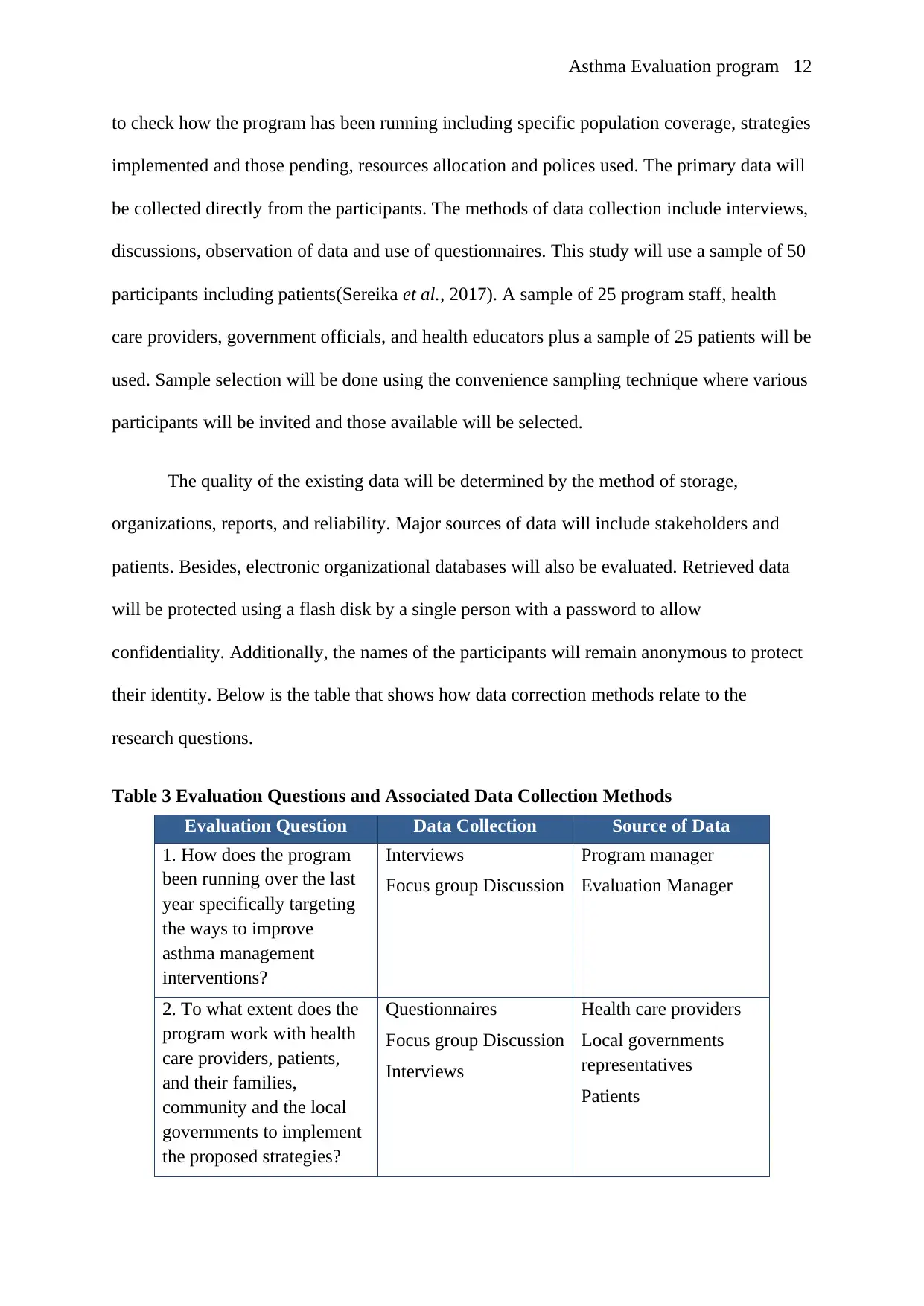
Asthma Evaluation program 12
to check how the program has been running including specific population coverage, strategies
implemented and those pending, resources allocation and polices used. The primary data will
be collected directly from the participants. The methods of data collection include interviews,
discussions, observation of data and use of questionnaires. This study will use a sample of 50
participants including patients(Sereika et al., 2017). A sample of 25 program staff, health
care providers, government officials, and health educators plus a sample of 25 patients will be
used. Sample selection will be done using the convenience sampling technique where various
participants will be invited and those available will be selected.
The quality of the existing data will be determined by the method of storage,
organizations, reports, and reliability. Major sources of data will include stakeholders and
patients. Besides, electronic organizational databases will also be evaluated. Retrieved data
will be protected using a flash disk by a single person with a password to allow
confidentiality. Additionally, the names of the participants will remain anonymous to protect
their identity. Below is the table that shows how data correction methods relate to the
research questions.
Table 3 Evaluation Questions and Associated Data Collection Methods
Evaluation Question Data Collection
Method
Source of Data
1. How does the program
been running over the last
year specifically targeting
the ways to improve
asthma management
interventions?
Interviews
Focus group Discussion
Program manager
Evaluation Manager
2. To what extent does the
program work with health
care providers, patients,
and their families,
community and the local
governments to implement
the proposed strategies?
Questionnaires
Focus group Discussion
Interviews
Health care providers
Local governments
representatives
Patients
to check how the program has been running including specific population coverage, strategies
implemented and those pending, resources allocation and polices used. The primary data will
be collected directly from the participants. The methods of data collection include interviews,
discussions, observation of data and use of questionnaires. This study will use a sample of 50
participants including patients(Sereika et al., 2017). A sample of 25 program staff, health
care providers, government officials, and health educators plus a sample of 25 patients will be
used. Sample selection will be done using the convenience sampling technique where various
participants will be invited and those available will be selected.
The quality of the existing data will be determined by the method of storage,
organizations, reports, and reliability. Major sources of data will include stakeholders and
patients. Besides, electronic organizational databases will also be evaluated. Retrieved data
will be protected using a flash disk by a single person with a password to allow
confidentiality. Additionally, the names of the participants will remain anonymous to protect
their identity. Below is the table that shows how data correction methods relate to the
research questions.
Table 3 Evaluation Questions and Associated Data Collection Methods
Evaluation Question Data Collection
Method
Source of Data
1. How does the program
been running over the last
year specifically targeting
the ways to improve
asthma management
interventions?
Interviews
Focus group Discussion
Program manager
Evaluation Manager
2. To what extent does the
program work with health
care providers, patients,
and their families,
community and the local
governments to implement
the proposed strategies?
Questionnaires
Focus group Discussion
Interviews
Health care providers
Local governments
representatives
Patients
⊘ This is a preview!⊘
Do you want full access?
Subscribe today to unlock all pages.

Trusted by 1+ million students worldwide
1 out of 21
Related Documents
Your All-in-One AI-Powered Toolkit for Academic Success.
+13062052269
info@desklib.com
Available 24*7 on WhatsApp / Email
![[object Object]](/_next/static/media/star-bottom.7253800d.svg)
Unlock your academic potential
Copyright © 2020–2025 A2Z Services. All Rights Reserved. Developed and managed by ZUCOL.





